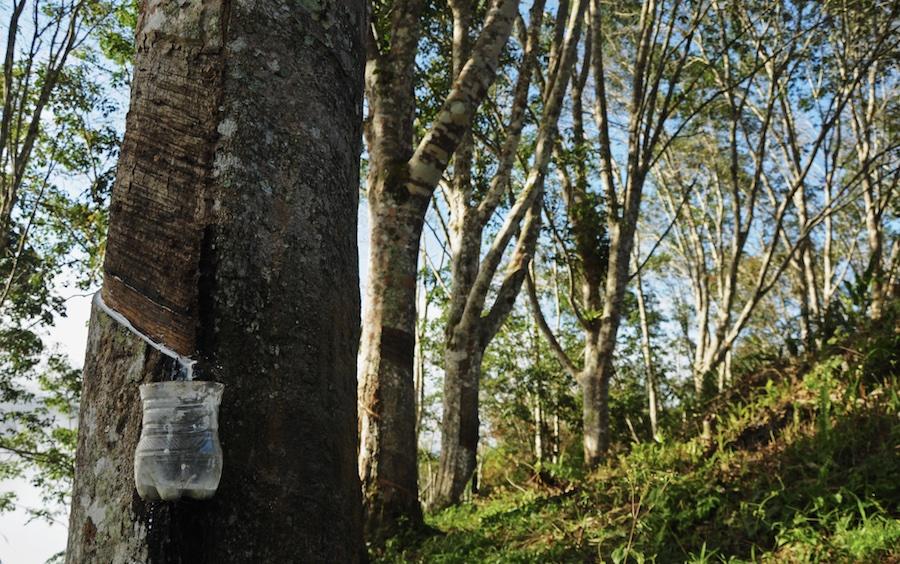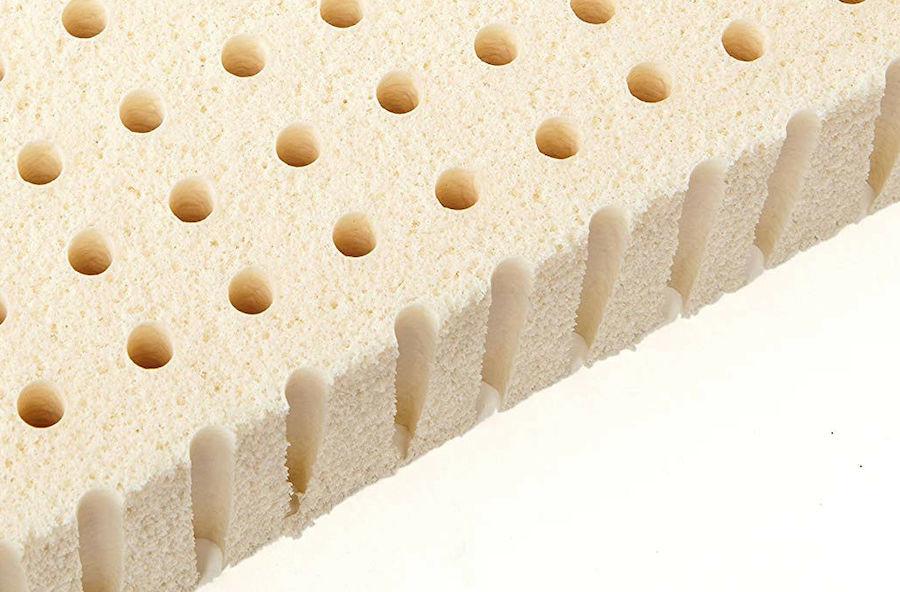There are so many types of foam, and Latex foam is a common one, often suggested when discussing mattresses, but what is Natural Latex foam? How does it differ from standard Latex foam?
I’ll answer that here for you in brief, and then we’ll get into some further details about natural Latex foam…
Natural latex foam is made from a blend of liquid latex and some synthetic ingredients. Often used in lower to middle layers within mattresses. Natural latex provides more bounce and comfort than standard latex due to increased rubber content and contains fewer chemicals, so less off-gassing.
Natural Latex foam is made from liquid latex from the rubber tree, it undergoes a long vulcanization process. Which essentially is a process in which rubber is hardened. During the production of latex foam, there are a few variations in the process.
All of these operations though can be equally carried out with 100% natural latex, 100% synthetic latex, or a combination of natural and synthetic latex. Only 100% organic Latex misses some of these processes.
Natural Latex foam origin
Natural latex comes from the Hevea brasiliensis plant, also known as the rubber tree, and is composed of milky white liquid.
Rubber trees are native to South America and were widely disseminated in the 19th century due to their high economic value.
Today, latex is also harvested in Sri Lanka. Since their introduction to Sri Lanka, rubber trees have flourished.
This has resulted in the growth of a massive natural rubber products industry centered around the island’s abundant natural latex supply.
Rubber trees are tapped in a way that is very close to how maple trees are tapped for maple syrup. After a small portion of the bark is carved away, latex begins to flow from the cut and into the containers below.
Here’s a picture showing the process of latex rubber extraction in progress on a Hevea brasiliensis tree…

Latex is only produced after a rubber tree has been growing for many years and entered its prime age …and each tree can yield sap for up to twenty or thirty years if properly cared for.
To maximize yield, the tree’s cuts are modified on a regular basis. After the latex from the rubber trees is extracted, it is thickened (by removing excess water) and delivered to factories for further processing.
Natural Latex feel
The feel of 100 percent natural latex foam is both comfortable and springy. Natural latex foam is extremely durable too and will outlast just about any other mattress component.
Although natural latex foam does have an odor, it is typically much milder and less abrasive than synthetic latex.
In fact, emissions are so low, that the vast majority of truly 100 percent natural latex foam products can pass the most strict textile and furniture emissions requirements, this includes Oeko-Tex and Greenguard certification.
Natural latex foam’s biggest downside is that it is not always as aesthetically appealing as synthetic latex foam. There might be tiny air pockets and aesthetic inconsistencies. Although these inconsistencies typically have no bearing on the foam’s comfort.
Advantages of natural latex foam
Latex foam has some advantages well worth a mention that make it perfect for both general and some other specific uses…
Comfort
A sensitive surface for pressure relief and adequate support for your spine and shape is needed for a good night’s sleep. Natural latex foam is so adaptable that it can meet all of these requirements.
A natural latex mattress can be made very soft, very firm, or a wide variety of choices in between using a customizable, layered design — even on different sides of the mattress.
Natural latex, unlike many other types of foam, does not absorb any moisture and heat buildup inside the mattress, specific air holes typically added in the manufacturing process assist greatly with the ventilation of the mattress.
Sustainability
Rubber tree sap, also known as rubber serum, is used to make natural latex foam. The tree’s bark recovers quickly after the serum is extracted.
Latex can be produced by rubber trees for up to thirty years. The field is replanted after the trees are harvested. According to the Sustainable Furnishings Council, rubberwood is one of the hardest and most recommended furniture woods.
Durability
Most natural latex mattresses last the same amount of time as two or three traditional mattresses …while maintaining their shape and excellent resilience.
Purchasing a mattress made of high-quality, natural materials is well worth any additional cost of the initial purchase.
If you want a mattress that helps you sleep cooler than the average foam mattress, then natural latex is a great option.
Natural Latex foam’s cellular structure is open. Air is infused into the latex compound to create this open-cell design, which in turn creates a cooler sleeping surface.
This innovative mattress design allows cool air to flow through the mattress as you sleep, allowing the heat your body creates to escape rather than being stuck next to your body during the night.
The movement of air also aids in the evaporation of moisture.
When you combine these properties with latex’s natural resistance to mold, mildew, and dust mites, you have the ideal safe sleeping surface.

Natural vs Synthetic Latex foam
100% natural latex foam is as mentioned before, created by harvesting sap from rubber trees.
The sap is dried further by allowing the water content to evaporate, it then becomes thicker, and relieved of all the extra moisture and water within it.
It is then poured into molds, after which either of the two processes – Dunlop and Talalay, take place.
The initial process of the manufacturing of synthetic latex is exactly the same as natural latex, however, before it is poured into a mold and further processed, chemicals and fillers are added to the liquid latex thus creating synthetic latex foam.
This version of foam is made for many reasons, cost-cutting and simply customer preference being among them.
In comparison to natural latex, synthetic latex foams can tend to off-gas more often and can be subjected to mold, mildew, and even dust mites.
Synthetic latex foams also tend to be less springy with a very slight compromise on comfort is also what sets the two types apart.
However, even with these minor downsides, the price of synthetic latex, which is much cheaper than that of natural latex is its major upside.
To add some further comparisons, here’s a table outlining the strengths of Latex against other foam types of Memory foam and Polyurethane foam.
| Foam Type | Latex | Memory | Polyurethane |
|---|---|---|---|
| Materials/Chemicals | |||
| Rubber tree sap | Yes | No | No |
| Formaldehyde | No | Yes | Yes |
| Petroleum derivatives | No | Yes | Yes |
| Flame retardant | No | Yes | Yes |
| Antioxident | Yes | No | No |
| Performance | |||
| Life span | <=20 years | <=10 years | <=10 years |
| Shape return | Instant | 1 Minute | Instant |
| Long term shape retention | Excellent | Fading | Good |
| Density (Ib per cubic feet) | |||
| Low density | < 4.3 | < 3 | < 1.5 |
| Medium density | Avg. 4.8 | Avg. 4 | Avg 1.6 |
| High Density | > 5.3 | > 5 | > 1.7 |
| Comfort | |||
| Temperature balance | Excellent | Poor/Medium | Poor/Medium |
| Relief of pressure | Very good | Excellent | Medium/Fair |
| Weight/body support | Excellent | Medium/Fair | Good |
| Motion Transfer | Medium/Fair | Low/minimal | Medium/Fair |
| Breathability | Good | Medium/Fair | Medium/Fair |
Cost
Natural Latex foam is certainly more expensive than standard Latex foam. For example, a good standard Latex foam pillow will cost you in the region $49 – $75.
By contrast, a Natural Latex foam pillow will likely cost you around $60 to $100, while an Organic Latex Pillow would fall in the region of $75 to $120.
As with most things organic, the increase in costs underlies the growing natural state of the latex. This is mainly because the rubber part of the pillow is the most expensive component, the more natural the pillow, the more rubber content, and hence the higher price point.
Buying Tips for Natural Latex Foam
If you’re looking at Natural Latex as a purchase, then there are some tips I can give you to look out for.
Tips when shopping for Natural Latex
- In addition to selecting your foam grade, you will have the option of wrapping your cushion in cotton to give it a fuller appearance. I’d recommend doing this at the time of purchase.
- If you want a more modern-looking flat pillow and don’t want to hide or disguise its natural look, order a half-inch thicker foam than the covers boxing to avoid unflattering wrinkles on the cover.
- When buying a mattress, make sure the depth of the foam is right for your needs. As an extra tip – If you’re not sure about the depth, go for slightly deeper size foam than your gut tells you, you’ll probably be glad you did.
Maintain the life of your Natural Latex foam
We recommend buying a case or cover with your natural foam because natural foam can also have naturally occurring imperfections.
Keep the foam indoors and away from direct sunlight to preserve its natural look. Overexposure can cause the rubber to dry out and become brittle.
Natural Latex foam can be spot washed with water and a mild soap solution. Remove the cover if it gets damp and let it dry before adding it back onto the mattress.
To finish
I hope this has answered the question of what is Natural Latex Foam. Be sure to check out my other articles for more research on which foam suits your needs.
